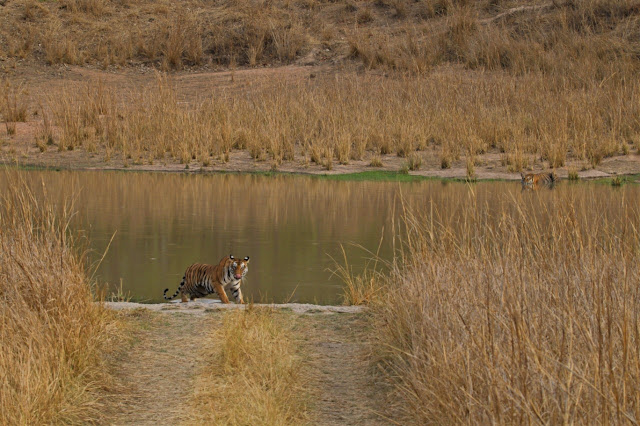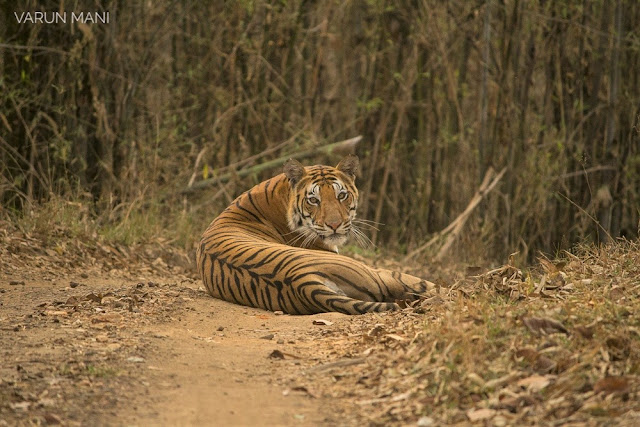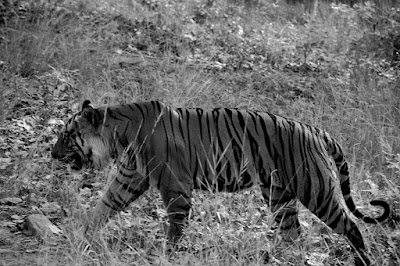Rajbehra
Speaking
of cubs another tigress who I loved watching was the Banbehi female. Mother to
three cubs when I saw her, she and Bamera would watch over the cubs in shifts and
a memorable day was when I saw Banbehi and Bamera work as a team. With both
slightly hysterical about the unresponsive cub who remained hidden behind a bush,
I saw Banbehi lead the way scouring every bush, while Bamera walked laboriously
behind her calling in a pleading manner for the cub to make an appearance. With
Banbehi’s tail held high and swishing every now and then, it was interesting to
observe the tiger as more than a predator, a worried mother.
Banbehi
Two
tigresses who have grown to be real keepers of their fortress have been daughters
of the stunning blue- eyed boy of Bandhavgarh and the beautiful Sukhi Patiya
female. Named Spotty and Dotty owing to their stripe markings they have been a
crowd favourite, offering leisurely sightings to those in need of one. With
Spotty being the bigger of the two and almost resembling a male, she was the first
tiger my mother ever saw. Walking along the forest track with her tail held high
in anticipation of marking her territory, she gave us quite a show, staring at
us curiously as we drove past her, her piercing blue eyes, passed down to her
from her father. I remember being only privy to stories of Dotty back then till
I saw her with the magnificent Mahaman male or ‘Mamu’ as he is fondly called,
courting and calling out to each other. The next time I saw her was she had littered,
and I had the good fortune of hearing her call out to her cubs as she sashayed
down the forest track.

Sukhi Patiya. Photo credit: Aniket Gupta
Dotty with Sukhi Patiya cub (currently the Dabadol female). Photo credit: Aniket Gupta
Moving from the beautiful Bamboo forests
to the Sal forests of Kanha, the first tiger I ever saw was the striking Choti
Mada. Patrolling her territory on the far end of Bishanpura meadow, that encounter with her was quite brief. A
memorable one was when we were happily trundling along looking for birds and a
forest guard on a bike signalled to us desperately. As we hurried forward, he pointed
behind him at a Sal tree. There she was! Eyes, a striking shade of obsidian, she
was marking happily on a tree and I could hear her sniffing at the other flora
around. Relaxed and seemingly happy, she started walking along the forest track
into the sun and looked back at us. That’s when I noticed her chocolate brown
eyes that had seemed obsidian black just minutes ago. With a flick of her tail
and shake of her head she was gone but left an everlasting impression on me.
Choti mada. Photo credit: Varun Mani
The
next lady from Kanha I had the opportunity of meeting was the regal Dhawajhandi.
Fascinated by her name, the best encounter I have had with this tigress is when
she suddenly appeared on the forest track and started calling out to her cubs. “aan
aan” in a throaty yet soft voice, she did twice or thrice and walked, tail in
their air to mark her territory. Within minutes we hear something rustling in
the bushes and three bundles of fur tumbled out of the grass. Sprinting to keep
up with the magnificent mum, the family disappeared as suddenly as they had appeared.
Dhawajhandi. Photo credit: Varun Mani
Dhawajhandi and cubs
My
favourite from the lush Sal jungle, however, is the calm MV3 (named after the Mahavir
clan). A young tigress, MV3 reminds me of the Rajbehra female of Bandhavgarh. Similarly
calm in disposition, my favourite encounter with MV 3 was when she was resting out
the summer heat with her head atop a rock in the water. Oblivious of her
admirers, only her ears showed any sign of movement to flick the flies away,
the only intruders to her serene environment.
MV 3 in her habitat
MV 3 on the Sal lined road
As
recently as last year, I had the good fortune of seeing the superbly elusive
Umarjhola female. Known to be extremely shy, we had to wait for her to come out
of the undergrowth for an hour. Known to haunt the Sondar water body, she
appeared with her body close to the ground making herself seem as inconspicuous as possible. The only time we could see
her properly was when she decided she wanted a drink of water and waded though
the shallow water body causing mass hysteria among the other visitors to the
lake. After observing her for half an hour, we left her half submerged, the
mysterious ‘Tedi poonch’ (famous for a dent in her tail) for who she was, a
silhouette by the lake and a powerful force surrounded by alarm calls and the
pink hue of the setting sun.
Umarjhola
The last tigress I would
like to mention is from Panna. The stunning matriarch T -1 to whom we attribute
the success to. Originally from Bandhavgarh where she was known as the Bhitri
female, the first time I saw T-1 was by the Karnavati. Her ochre in contrast to
the blue of the river was breath taking. As she strode powerfully on the bank
of the river accompanied by the background score of a hysterical lapwing flying
overhead, I realised how honoured I was to keep such august company.
T- 1, the grand matriarch of Panna. Photo credit: Aniket Gupta
| 













Interesting. You have been lucky to sight various tigresses. Could sense the joy in your verdant writing. Please keep writing.
ReplyDeleteThank you so much!
DeleteBrilliant!
ReplyDeleteLoved it. The local names of these beauties makes the narrative so real that it’s almost surreal.wonderfully articulated. More power to your quill.👍👍🙏
Thank you so much!
Delete